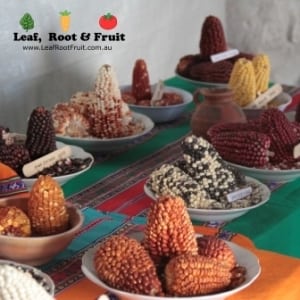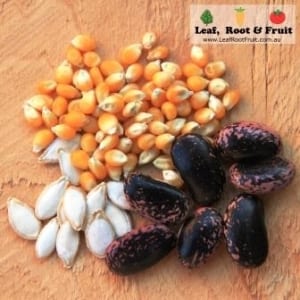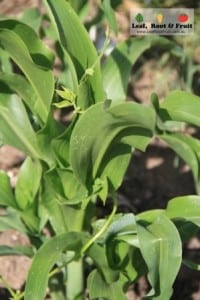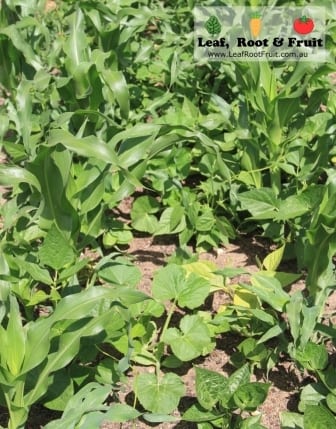During 2012, my partner Caryn and I spent a gap year in South America. During our trip we developed a keen appreciation of the agricultural practices of the local inhabitants. One of the ancient planting techniques still used there today is the ‘Three Sisters’, a fantastic companion planting technique.
According to legend, corn (maize), beans, and squash (pumpkin) are three inseparable sisters who can only thrive when grown together. The ancient wisdom dictates that corn especially must grow in community with other crops rather than on its own. It needs the beneficial company and aide of its companions to thrive. Corn, beans and squash were among the first important crops domesticated by ancient Mesoamerican societies. Corn was especially important, providing more calorie yield per area than any other.
Put into practice, the corn provides a structure for the beans to climb, eliminating the need for poles. The beans provide the nitrogen to the soil that the nitrogen hungry corn and squash utilize. The squash (or pumpkin) spreads along the ground, blocking the sunlight, helping prevent establishment of weeds. The squash leaves also act as a “living mulch”, creating a microclimate to retain moisture in the soil, and the prickly hairs of the vine deter pests. Corn lacks the amino acids lysine and tryptophan, which the human body needs to make proteins and niacin, but beans contain both. Squash yields important vitamins from the fruit. Growing all three crops helped the ancient Americans to provide a balanced diet.
Things to consider when trying your own Three Sisters Gardening technique:
Ancient vs modern Three Sisters Gardening

There are hundreds of varieties of maize or corn grown in South America. Most of them are dried on the cob for storage.
Be aware that the varieties of corn, squash and beans grown by the Native Americans were typically grown for drying. The three varieties of plant were allowed to grow to full maturity and then were harvested all at once, at the end of season. We tend to use modern cultivars of sweetcorn in our veggie patches. These need harvesting well before maturity to retain the flavour by preventing the sugars being converted to starch. Similarly, we tend to eat our beans fresh, or we blanch and freeze them. Therefore, if you want to have a go yourself, you’ll need to modify the technique slightly to accommodate this.
Access for harvesting
If you try growing your sweetcorn in a typical modern block of rows formation and apply the Three Sisters technique, then you risk creating a problem of access for harvesting. You’ll get overrun with squashes and possibly beans. Traditionally the Three Sisters used a circular planting pattern. Consider an arrangement of using squashes or pumpkins in the middle and corn and beans in rings around the outside.
Timing of sowing seed
Success with a Three Sisters garden involves careful attention to timing, seed spacing, and varieties. If you simply plant all three in the same hole at the same time, the result will be a snarl of vines in which the corn gets overwhelmed. You will need to let the sweetcorn get a head start to prevent this. Usually you should plant the sweetcorn seed, wait two weeks and plant the beans and then wait a further two weeks prior to planting the squash or pumpkin.
Three Sisters Gardening Varieties
Why limit yourself to beans and squash for your sweet corn companions? We’re planning on using similar companion planting principles but with different varieties. Just remember, that the legumes fix nitrogen in the soil and are included to feed the hungry corn plants. So make sure if you substitute the beans, that you swap them for a similar legume. Some potential substitutes for beans:
- Peanuts (these are a good ground cover, so they could form part of a ‘two-sisters’ planting technique)
- Soybeans (edamame!)
- Peas
- Snow peas
- Bush varieties of beans (simply cut the corn plants back when you’ve finished harvesting them)
- Clover
Consider substituting squash with other cucurbits, such as:
- Watermelon
- Pumpkin
- Cucumber
- Cantaloupe or other melons
- Zucchini
- Zucchini tromboncino
Be careful with your choice of cucurbit. They are vigorous growers, and may end up taking over!
Size of your Three Sisters Garden
The size of the plot you dedicate to Three Sisters gardening in is not overly important. However, we recommend that every time you grow sweetcorn, that you plant enough seed to ensure that you have at least 30 plants. Any less than this and you will likely run into issues associated with poor pollination. Poor pollination is evident if you grow deformed, or underdeveloped cobs.
Mulching your Three Sisters Garden Bed
The squash (or pumpkin) does a good job at preventing weeds and creating a microclimate. However, we’ve found that during the harsh Melbourne summer, that a good layer of straw mulch helps to retain a lot more moisture in the soil than just by growing pumpkin vines alone. Early on in the growing season, when the pumpkin plants are smaller and the sweetcorn requires plenty of water, this supplementary mulch is especially useful.
I’ll be using a few variations of the Three Sisters gardening technique this summer. What about you? Are you going to give it a go? Which combination of cultivars will you be using?






Thank you for sharing these wonderful gardening ideas! Must try the concept.
Hi Barry,
Glad you’ve found it useful. Please keep us updated on progress!
Good Luck and Happy Gardening.
Duncan
I am anewbie in gardening. I have just started planting tomato seeds indoor 2 weeks ago and love seeing the growth of seedlings. Thanks for all the tips.its been really helpful especially to know about when and what to grow in Melbourne weather. I got sweet corn and cucumber seeds and excited to sow them in the garden bed.
Glad you have found our website inspiring Rajeswari.
Good Luck & Happy Gardening!
Definitely going to give this a go…. looks like great fun. Wonderful corn for the chooks. So enjoy your reads..
Hi Jane, glad you found it useful and inspiring!
Love this idea! We also rent so I was thinking of planting corn in pots on the unused part of the driveway. If I was to plant a legume and a corn stalk in each pot, what size pot would you recommend?
Thanks!
Hi Kylie.
Corn needs a lot of water and nutrient. I wouldn’t advise growing them in pots. You will need at least a 30 to 40cm pot for each plant. Corn are wind pollinated, so you need to grow at least 20, but preferably 30 plants to ensure good pollination. In my opinion, you are better aiming for something that will give you a better return for your effort.
Good luck with the season ahead!
Duncan